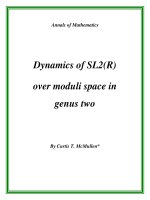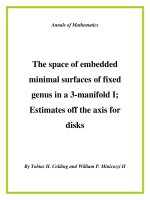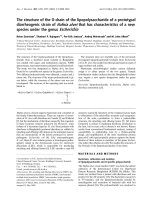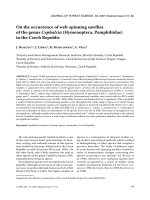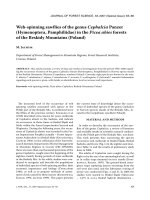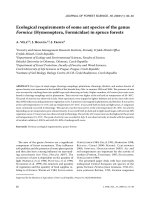genus holoplatys spiders
Bạn đang xem bản rút gọn của tài liệu. Xem và tải ngay bản đầy đủ của tài liệu tại đây (15.63 MB, 71 trang )
AUSTRALIAN MUSEUM
SCIENTIFIC PUBLICATIONS
Zabka, Marek, 1991. Salticidae (Arachnida: Araneae) of Oriental, Australian
and Pacific Regions, V. Genus Holoplatys Simon, 1885. Records of the Australian
Museum 43(2): 171–240. [22 November 1991].
doi:10.3853/j.0067-1975.43.1991.46
ISSN 0067-1975
Published by the Australian Museum, Sydney
nature
nature culture
culture discover
discover
Australian
AustralianMuseum
Museumscience
scienceisisfreely
freelyaccessible
accessibleonline
onlineatat
wwwww.
a
u
s
t
r
a
l
i
a
n
m
u
s
e
u
m
.
n
e
t
.
a
u
/
p
u
b
l
i
c
a
w. a u s t r a l i a n m u s e u m . n e t . a u / p u b l i c atti o
i onnss/ /
66 College
College Street,
Street, Sydney
Sydney NSW
NSW 2010,
2010, Australia
Australia
Records of the Australian Museum (1991) Vol. 43: 171-240. ISSN 0067-1975
Salticidae (Arachnida: Araneae) of Oriental,
Australian and Pacific Regions, V.
Genus H oloplatys Simon, 1885
MAREK ZABKA
Visiting Fellow, The Australian Museum,
PO Box A285, Sydney, NSW 2000, Australia
Present Address: Zaktad Zoologii WSR-P,
08-110 Siedlce, Poland
ABSTRACT. The spider genus Holoplatys Simon is revised. Its relationships, origin and distribution
are discussed. Six species groups based on genitalia and body structure are distinguished and key
for their identification in proposed. Holoplatys caledonica Berl., H. urvillei Dalmas, H. Jractivittata
Sim. and H. quinquecinqulata Sim. are excluded from the genus. Ocrisiona complanata (L.K.),
O. invenusta (L.K.) and O. fusca (Karsch) are included in Holoplatys. A total of 37 species are
described and figured, including 31 new species: bicoloroides, borali, braemarensis, bramptonensis,
canberra, chudalupensis, colemani, complanatiformis, daviesae, dejongi, desertina, embolica,
grassalis, jardinensis, julimarina, kalgoorlie, kempensis, lhotskyi, mascordi, meda, minuta, oakensis,
panthera, pedder, pemberton, rainbowi, queenslandica, semiplanata, strzeleckii, tasmanensis and
windjanensis.
ZABKA, M., 1991. Salticidae (Arachnida: Araneae) of Oriental, Australian and Pacific Regions, V. Genus
Holoplatys Simon, 1885. Records of the Australian Museum 43(2): 171-240.
Contents
Introduction .......................................................................................................................................... 172
Material and methods ........................................................................................................................ 172
Taxonomic survey ............................................................................................................................... 172
Holoplatys Simon ........................................................................................................................... 172
Type species ................................................................................................................................... 172
Diagnosis ......................................................................................................................................... 172
Description ....................................................................................................................................... 172
171
172
Records of the Australian Museum (1991) Vol. 43
Biology and relationships ............................................................................................................... 175
Distribution ....................................................................................................................................... 175
Key to species groups of Holoplatys .......................................................................................... 175
The complanata group ................................................................................................................... 176
The planissima group ..................................................................................................................... 199
The grassalis group ........................................................................................................................ 217
The panthera group ........................................................................................................................ 228
The bicolor group (incertae sedis) ............................................................................................... 233
The invenusta group (incertae sedis) ........................................................................................... 233
Acknowledgments .................................•............................................................................................... 239
References ............................................................................................................................................. 239
A recent survey of the Australian Salticidae
provides the list of 57 genera, most of them endemic
(Davies & Zabka, 1989). Seven species are recorded
from the genus Holoplatys (Simon 1901b, 1909; Dalmas,
1917; Berland, 1932; Koch, 1879), but an examination
of type and new material shows that the real number
of species is far greater. Thirty one new species are
recognised and, in comparison to Bonnet's list (1957),
the generic status of four species is altered. Holoplatys
caledonica Berland, 1932, H. Jractivittata Simon, 1909
and H. quinquecinqulata Simon, 1909 are transferred to
new genera (Zabka, in preparation). Holoplatys urvillei
Dalmas, 1917 should be included in Trite Simon. At the
same time Ocrisiona complanata (L. Koch, 1879), O.
invenusta (L. Koch, 1879) and O. Jusca (Karsch, 1878)
have been transferred to Holoplatys. Ocrisiona cinerea
(L. Koch, 1879) and O. liturata (L. Koch, 1879)
probably also belong to Holoplatys but as neither adult
type specimens nor fresh material of either species are
available, they are not included here.
Basically, the type species, H. planissima (L. K.) is
the only species in the genus to have been studied in
any detail (Pr6szynski, 1984; Davies & Zabka, 1989).
differences do not provide enough clearly defined
characters for a species identification key to be
constructed. Only a key for the species groups is
proposed.
Collections studied include: AMS - Australian
Museum, Sydney; ANIC - Australian National Insect
Collection CSIRO, Canberra; MNHN - Museum National
d'Histoire Naturelle, Paris; QMB - Queensland
Museum, Brisbane; SAMA - South Australian Museum,
Adelaide; TMH - Tasmanian Museum and Art Gallery,
Hobart; WAMP - Western Australian Museum, Perth;
2MB - Zoologisches Museum der Humboldt-Universitat,
Berlin; ZMH - Zoologisches Institut und Zoologisches
Museum, Universitat Hamburg. Abbreviations used are:
AEW - anterior eyes width, ag - accessory gland, AL
- abdomen length, cd - cephalic depression, cf - cymbial
flange, CL - cephalothorax length, CW - cephalothorax
width, da - dorsal tibial apophysis, e - embolus, EFL
- eye field length, ep - epigynal pocket, fd - fertilisation
duct, id - insemination duct, m - metatarsus, p prolateral spines, PEW - posterior eyes width, r retrolateral spines, s - spermatheca, sc - abdominal
scutum, sd - seminal duct, t - tibia, tg - tegulum, ta
- lateral tibial apophysis.
Material and Methods
Taxonomic Survey
The work is based on type specimens from European
collections listed by Pr6szynski (1971) and on new
material borrowed from several Australian museums and
collected by the author. Twenty two species were
described from one sex only and of these 18 were from
a single specimen. The full list of collections used is
presented below. Means (in brackets) and ranges are
given in millimetres. The details of terminology are
illustrated in Figure 1. Format of leg spination
follows Platnick & Shadab (1975). Dissected epigynes
were digested in lactic acid for 10 to 30 minutes or in
10% KOH for 12 to 48 hours at room temperature,
rinsed in distilled water, stained in ethanol solution
of chlorazol black E under control and then mounted
in glycerin. The drawings were made using grid
system. New specific names are derived from
localities or, in other cases, their etymology is
explained.
Close affinities within the genus and very fine specific
Holoplatys Simon
Marptusa [part] L. Koch, 1879: 1100.
Holoplatys Simon, 1885: 88.
Ocrisina [part] Simon, 1901: 595, 602, 604, 608.
Type species. Marptusa planissima L. Koch, 1879, by
monotypy.
Diagnosis. Genitalia structure, very flat body and
cephalic depressions between posterior lateral eyes
separate Holoplatys from other Australian genera. Tibial
spines on first and second legs absent in most species.
Description (Fig. 1). Tiny to large spiders, ranging
from 2 to 11 mm in length. Body flat and narrow.
Thoracic part of cephalothorax distinctly longer (up to
Zabka: Arachnida, Araneae, Holoplatys
72% of total length) than cephalic part. Fovea displaced
backwards, indistinct or not visible. Most species with
2 shallow cephalic depressions. Abdomen elongate, often
with anterior scutum - better marked in males. Clypeus
very narrow, in some species with fringe of short white
hairs. Chelicerae small or very small, displaced backwards
(Fig.IB), of unident pattern, with 2 promarginal teeth
and I retromarginal tooth, the last sometimes missing.
Maxillae and labium elongated. Legs I long and strong,
especially in planissima group, their tibiae and metatarsi
often cone-shaped, patellae and tibiae sometimes fringed.
Legs III the shortest, IV the longest or as long as I.
o
.. \
~Cd
r~o
Spines on tibia and metatarsus I and 11 usually (but not
always) absent.
On the basis of general body form, colour pattern and
genitalic structure six species groups are proposed:
eomplanata, planissima, grassalis, panthera, hieolor and
invenusta. Palpal organ (Figs IC-E, 2A-T) with sac-like
tegulum, seminal duct not meandering, embolus of
variable length. Lateral tibial apophysis short. In
planissima (Fig.2F-J), grassalis (Fig.2K-Q) and panthera
(Fig.2R) groups dorsal tibial apophysis missing, but
dorsolateral one present. Holoplatys invenusta with
cymbial flange. Palpal organ of eomplanata group
~-B-~
!····~E~
W+··. . -·- ..
.
(
"
173
.......
...J
«
H
~
\/
ep
Fig.l. Morphological characters of Holoplatys: A - dorsal view, B - lateral view of cephalothorax, C-E
- palpal organ, F-H - female genitalia. (Abbreviations in the text).
174
Records of the Australian Museum (1991) Vol. 43
Fig.2. Morphological series of palpal organs in the genus Holoplatys. complanata group: A - H. complanata,
B - H. pedder, C - H. colemani, D - H. senilis, E - H. semiplanata, planissima group: F - H. mascordi,
G - H. planissima, H - H. strzeleckii, I-H. pemberton, J - H. fusca, grassalis group: K - H. grassalis,
L - H. chudalupensis, M - H. daviesae, N - H. dejongi, 0 - H. kalgoorlie, P - H. embolica, Q - H.
lhotskyi, panthera group: R - H. queenslandica, bicolor group: S - H. bicolor, invenusta group: T - H.
invenusta.
Zabka: Arachnida, Araneae, Holoplatys
(Fig.2A-E) similar to that in the genus Ocrisiona Simon.
Epigyne and internal genitalia uniform in structure.
Copulatory openings usually clearly visible, more or less
distant from the epigastric furrow. Insemination ducts
usually long. Spermathecae pear-shaped. Accessory glands
relatively large, straight or curved, their shape and
position of diagnostic value. Fertilisation ducts distinct.
Posterior margin of epiqyne indented or not, sometimes
accompanied by pockets.
175
similar to that of species of the complanata group. Other
species groups show reduced body size, tibial spines and
cheliceral teeth and seem to be more specialised. Some
other genera (including new ones) resemble Holoplatys
in body form, and female genitalia, but their leg
spination and palpal organs are usually different (Zabka,
in preparation).
Distribution
Biology and Relationships
To better understand the morphology, number of
species and relationships of Holoplatys, the climatic,
vegetational and topographic history of Australia have
to be considered. As a result of the onset of dryer
climatic conditions in the late Tertiary and Quaternary
the range of loose-barked trees (mainly Eucalyptus)
increased enormously, providing good conditions for
explosive speciation of bark inhabitants. Hypothetically,
the ancestors of Holoplatys were probably
morphologically similar to other genera of jumping
spiders but specialised as crevice dwellers became
dorsally compressed to efficiently utilise narrow underbark spaces. With the exception of bark dwellers,
single species have been collected on herbs and grass.
Jackson & Harding (1982) note that the rolled-up leaves
of the New Zealand flax (Phormium tenax) are a habitat
of two undescribed species. The same paper provides
interesting behavioural studies - the only available for
the genus.
Ocrisiona seems the closest relative of Holoplatys
(Zabka, 1990). The genital structure of both genera is
The distribution of Holoplatys (Maps 1-9) is restricted
to Australia, adjacent areas and New Zealand. Holoplatys
complanata (L. K.), H. jardinensis n.sp. and H.
queenslandica n.sp. are Australian species occurring in
Papua New Guinea (Port Moresby area), and H.
semiplanata n.sp. has also been recorded from New
Caledonia. Holoplatys senilis Dalmas has been described
from New Zealand and at least two other species from
the area require description (Jackson & Harding, 1982).
In fact, insufficient knowledge of the salticid fauna of
large parts of the region prevents useful comment on
the zoogeographic history of the genus. The maps of
distribution given are preliminary and tend to reflect
main centres of arachnological activity rather then real
distribution ranges. For some widely distributed species
ranges may have changed during the period of human
activity and settlement. Timber transports, for example,
could have been an excellent artificial dispersal
mechanism. Natural colonisation by ballooning is a
possible explanation for large distributions in spiders but
there is no evidence for this in Holoplatys. Strongly bark
adapted animals seem rather unlikely candidates for
ballooning dispersal anyway.
Key to Species Groups of Holoplatys
1.
Palpal organ without dorsal tibial apophysis ............................................................................ 2
- - Dorsal apophysis present .............................................................................................................. 3
2.
Medium to large spiders (5.70-10.60), tegulum without
lobe .................................................................................................................................................. 4
- - Smaller spiders, cephalothorax relatively high, tegulum
elongate, with posterior lobe .................................................................................. hicolor group
3.
Tiny to medium spiders (2.23-4.89), embolus delicate,
in most species thin and long. If embolus different
cephalothorax almost parallel-sided and its thoracic
part up to 72% of total length .................................................................................................. 5
- - Spiders larger (4.21-8.11), embolus massive, crescentlike, epigynal depression with distinctive margins ........................................ pianissima group
176
Records of the Australian Museum (1991) Vol. 43
4.
Embolus long and thin, black spiders or with
abdominal herring-bone pattern, sometimes tibial spines
present, shallow epigynal depression with no distinctive
margins ................................................................................................................ complanata group
- - Embolus shorter and tegulum larger than in the
complanata group, dorsolateral tibial apophysis present,
cymbium with flange, insemination ducts short and
vast, spermathecae large ....................................................................................... invenusta group
5.
Embolus usually thin and long or very long, epigyne
similiar to the planissima group .......................................................................... gras sa lis group
- - Embolus shorter, cephalothorax more elongate than
in other groups, almost parallel-sided ................................................................. panthera group
The complanata Group
The group consists of 14 species, widespread from
north Queensland through New South Wales to Western
Australia. Single specimens of two species have also
been recorded from Papua New Guinea, New Caledonia
and New Zealand.
With the exception of H. senilis Dalmas, H. pedder
n.sp. and H. colemani n.sp., all species show an
abdominal mosaic with central dark stripe and
herring-bone pattern. Body size 5.50-10.60 mm. Palpal
organ without dorsal tibial apophysis, embolus long
and thin. Epigynal depression with no distinctive
margins. Insemination ducts long or very long. Tibial
spines on legs I and (or) 11 usually absent but
120
135
present in H. pedder n.sp., H. senilis Dalmas and H.
windjanensis n.sp. General pattern of genitalic structure
almost identical to that found in the genus Ocrisiona.
Species included: complanata, pedder, senilis, colemani,
complanatiformis, canberra, jardinensis, bramptonensis,
rainbowi, meda, semiplanata, oakensis, kempensis,
windjanensis.
Holoplatys complanata (L. Koch) n.comb.
Figs 3-6, Map 1
Marptusa complanata L. Koch, 1879: 1093.
Ocrisiona complanata.-Simon, 1901: 602.
165
150
0
~o
.0.\\
.
"q,
.
15
~--~------~------+-------+7~~--T-~45
Map 1. Inverted closed triangle - H. colemani n.sp.; open square - H. complanata (L. Koch); closed circle
- H. pedder n.sp.; closed square - H. senilis (Dalmas).
Zabka: Arachnida, Araneae, Holoplatys
Material examined. Queensland: SYNTYPES, 2 males,
female, Port Mackay, Rockhampton, Gayndah, (Mus.
Godeffroy 16522), ZMH; female, Tryon Island, 21 Aug. 1977,
M. Jahnke, QMB S3582; female, Tryon Island, 21-29
Aug. 1971, H. Heatwole, QMB S3633; male, Homevale,
beating vine thicket, 1-7 Apr. 1975, V. Davies, QMB S4611.
Northern Territory: female, Roper River, M.J. Colclough,
QMB W2137(a). Papua New Guinea: male, Izzy Dizzy
Creek, Morobe Province, under bark of Araucaria
cunninghami, 24 Sept. 1970, B. Gray, AMS KS18860; female,
Bulolo, Morobe Province, 18 Aug. 1970, B. Gray, AMS KS
Fig.3. Holoplatys complanata, male (syntype).
177
13220.
Diagnosis.
herring-bone
longer than
curved and
walls.
Unlike pedder, senilis and colemani abdominal pattern present and embolus
semiplanata. Accessory glands laterally
join the spermathecae on their inner
Male (Fig.3A). Eye field black, thorax dark-brown,
178
Records of the Australian Museum (1991) Vol. 43
numerous white hairs along lateral surfaces. Abdomen
with orange anterior scutum and dark-grey pattern on
yellowish or beige background. Spinnerets grey.
Clypeus dark-brown with whitish hairs. Chelicerae darkbrown with transverse stripe of white setae proximally.
Fig.4. Holoplatys complanata, female (syntype).
Maxillae and labium dark-brown, the last with light tips.
Sternum dark-brown, venter dark-grey. Legs I blackbrown, others slightly lighter, especially their distal
segments.
Palpal organ (Fig.3B,C) with long embolus, tegulum
Zabka: Arachnida, Araneae, Holoplatys
oval and wide.
Leg spination. mI: pI-I, rI-I; mll: pI-I, rO-o or rI1.
Dimensions. CL 2.24-2.90 (2.48), CW 1.46-1.84
(1.60), CW/CL 0.63-0.67 (0.64), EFL 0.73-0.92 (0.81),
EFL/CL 0.31-0.35 (0.32), AEW 1.15-1.38 (1.22), PEW
1.18-1.38 (1.25), AL 2.83-3.60 (3.42).
Female (Figs 4A, SA, 6A). Cephalothorax brown with
darker surrounding of eyes. Abdomen with beige and
grey-brown pattern. Clypeus, chelicerae and maxillae
brown, the last with yellow tips. Labium brown, sternum
B]
d
c
Fig.5. Holoplatys complanata, female from Bulol0.
179
180
Records of the Australian Museum (1991) Vol. 43
light-brown, venter beige. Legs brown, dorsoventrally
darker, distally lighter.
Genitalia (Figs 4B,C, 5B,C, 6B,C) with long
insemination ducts, accessory glands curved laterally,
located on inner walls of spermathecae.
Leg spination. mI: pI-I, rI-I; mll: pI-I, rI-1.
Dimensions. CL 3.03-4.36 (3.87), CW 1.88-2.80
(2.44), CW/CL 0.62-0.64 (0.62), EFL 0.99-1.32 (1.19),
EFL/CL 0.29-0.32 (0.31), AEW 1.38-1.84 (1.67), PEW
1.41-1.91 (1.72), AL 5.41-6.40 (5.90).
Holoplatys pedder n.sp.
Fig.7, Map
Material examined. Tasmania: HOLOTYPE, male, Lake
Pedder, 11.1967, A.I. Dartnall, TMH I.588.
Diagnosis. Black, slender spider. White hairs along
cephalothorax form medial and marginal stripes. No
g[
0'
~I
Fig.6. Holoplatys complanata, female from Tryon Island.
Zabka: Arachnida, Araneae, Holoplatys
distinct scutum on abdomen, tibia I with single prolateral
spine.
Male (Fig.7A). Cephalothorax black with central and
marginal stripes of white hairs, its anterior part more
sclerotised but without distinct scutum. Spinnerets black.
Clypeus brown with white hairs centrally. Chelicerae
brown, maxillae, labium and sternum dirty-brown. Venter
grey-brown. Legs brown, lighter distally, lateral surfaces
Fig.7. Holoplatys pedder, male (holotype).
181
darker, white and brown hairs numerous.
Palpal organ (Fig.7B,C) almost identical to senilis and
colemani.
Leg spination. tI: pO-I; mI: pI-I, rI-I; mII: pI-I, rO1.
Dimensions. CL 3.12, CW 0.91, CW/CL 0.61, EFL
0.96, EFL/CL 0.30, AEW 1.32, PEW 1.34, AL 3.70.
Female. The female is unknown.
182
Records of the Australian Museum (1991) Vol. 43
Holoplatys senilis Dalmas
Figs 8,9, Map 1
Holoplatys senilis Dalmas, 1917: 416.
Material examined. New Zealand: male, female, MNHN
B2341. Probably type-material but neither specimen's status
nor locality marked on the original label.
Diagnosis. In comparison to pedder median stripe on
Fig.S. Holoplatys senilis, male (type?) from New Zealand.
Zabka: Arachnida, Araneae, Holoplatys
cephalothorax less distinct, anterior abdominal scutum
better marked. Tibia I with a single prolateral spine.
Insemination ducts relatively short.
Male (Fig.8A). Eye field black, thorax dark-brown
with scattered white hairs more numerous marginally.
Abdomen generally dirty-brown with large anterior
scutum and lighter posterior lines. Spinnerets greybrown. Clypeus dark-brown with cluster of white hairs
centrally. Chelicerae dark-brown with transverse stripe
of white hairs in their basal parts. Maxillae brown with
lighter tips, labium dark-brown, sternum brown, venter
183
grey. Legs I dark-brown, distally gradually lighter. Other
legs slightly lighter.
Palpal organ (Fig.8B,C) similiar to pedder.
Leg spination. tI: pO-I; mI: pI-I, rI-I; mll: pI-I, rI1.
Dimensions. CL 2.70, CW 1.81, CW/CL 0.67, EFL
0.85, EFL/CL 0.31, AEW 1.28, PEW 1.28, AL 3.36.
Female (Fig.9C). Cephalothorax coloured as in male
with white hairs scattered on eye field and more
numerous in fovea region and marginally. Abdomen
dark, grey-brown with whitish and brown hairs. Spinnerets
A
~l
Fig.9. Holoplatys senilis, female (type?) from New Zealand.
184
Records of the Australian Museum (1991) Vol. 43
black-brown. Clypeus and chelicerae black-brown, the
first with light scattered hairs. Pedipalps dark-orange
with white and yellow hairs. Maxillae and labium blackbrown, lighter distally with yellow tips, sternum blackbrown, venter grey-black. Legs I dark-brown, lighter
distally, hairs rather numerous, light and brown.
Genitalia (Fig.9A-B) with insemination ducts shorter
than in other species, accessory glands straight.
Leg spination. tI: pO-I, rO-o; mI pI-I, rI-I; mll: pI1, rI-I.
Fig.IO. Holoplatys colemani, male (holotype).
Dimensions. CL 4.35, CW 2.83, CW/CL 0.65, EFL
1.25, EFL/CL 0.29, AEW 1.74, PEW 1.91, AL 4.68.
Holoplatys colemani n.sp.
Figs 10,11, Map 1
Material examined. Queensland:
HOLOTYPE,
male,
Zabka: Arachnida, Araneae, Holoplatys
ALLOTYPE, female, Wolfram, 3 May 1977, N.C. Coleman,
AMS KS18815, KSI9119. New South Wales: PARATYPES,
male, Botany, 10 Dec. 1978, R. Mascord, AMS KS4140.
Etymology. The specific name is proposed in honour
of N. Clyde Coleman, Australian naturalist, collector of
the part of the material studied.
Diagnosis. Dark spider but without median stripe on
cephalothorax. In male first legs fringed, abdominal
scutum present. Spines on tibia I missing.
Male (Fig.1OA). Dark-brown spider with white
Fig.H. Holoplatys colemani, female (allotype).
185
hairs around margins of cephalothorax. Abdomen
with large anterior scutum. Clypeus black-brown
with long light and dark hairs. Chelicerae darkbrown with transverse stripe of white hairs. Maxillae
and labium dark-brown with yellow tips, sternum
brown, venter greyish-black. Legs I fringed, blackbrown, distal parts of tarsi orange. Other legs
lighter.
Palpal organ as in Figure lOB,C.
Leg spination. rnI: pI-I, rI-I; mll: pI-I, rl-l or 0o or 0-1.
Dimensions. CL 3.23-4.15 (3.69), CW 2.11-2.84
(2.47), CW/CL 0.65-0.68 (0.67), EFL 1.00-1.18 (1.09),
EFL/CL 0.28-0.30 (0.29), AEW 1.48-1.85 (1.66), PEW
186
Records of the Australian Museum (1991) Vo!. 43
1.51-1.91 (1.71), AL 3.76-5.08 (4.42).
Female (Fig.llA) generally as male but white
marginal hairs less numerous and abdominal scutum
absent. Clypeus brown-black with long hairs of the
same colour. Chelicerae, maxillae, labium and sternum
dark-brown, the first without frontal white hairs.
Venter grey, with 2 longitudinal rows of lighter spots.
Legs coloured as in male but shorter, legs I not
fringed.
Genitalia (Fig.llB,C) very similar to other species of
the group, especially to semiplanata.
Leg spination. ml: pI-I, rI-I; mll: pI-I.
Dimensions. CL 4.55, CW 2.97, CL/CW 0.65,
EFL 1.25, EFL/CL 0.27, AEW 1.98, PEW 2.04, AL
6.07.
Holoplatys complanatijormis n.sp.
Fig.12, Map 2
Material examined. Queensland: HOLOTYPE, female, Lake
Broadwater, Surveyors Gully, under bark, 27 Jan. 1985, M.
Bennie, V. Davies, QMB S6760; PARATYPES, female, Brisbane,
wasp nest, 24 Apr. 1974, V. Davies, QMB S4603. New South
Wales: PARATYPES, female, Dubbo, 31 July 1966, AMS
KS19120.
Diagnosis. Abdominal pattertJ. present but darker than
in related species. In comparison to complanata
insemination ducts shorter, join the spermathecae on
their lateral walls and position of accessory glands
different.
g]
d
Fig.12. Holoplatys complanatijormis, dorsal body of female (holotype) and genitalia of paratype trom tlnsoane.
Zabka: Arachnida, Araneae, Holoplatys
Male. The male is unknown.
187
Male. The male is unknown.
Female (Fig. 12A). Eye field dark-brown, thorax
brown. Numerous white hairs on lateral surfaces of
cephalothorax. Abdomen with light and dark-grey pattern,
covered with numerous grey-brown and white hairs.
Spinnerets greyish. Clypeus dark-brown with long white
hairs, without fringe. Chelicerae, maxillae, labium and
sternum dirty-brown, venter beige. Pedipalps yellow,
darker distally with white hairs. Legs I dark-brown,
lighter distally, darker laterally, other legs similar in
colour.
Genitalia as in Figure 12B,C. In comparison to related
species insemination ducts and accessory glands
different.
Leg spination. ml: pI-I, rI-I; mII pI-I, rI-1.
Dimensions. CL 3.23-3.63 (3.43), CW 2.08-2.37
(2.22), CW/CL 0.64-0.70 (0.67), EFL 1.00-1.12 (1.06),
EFL/CL 0.30-0.31 (0.31), AEW 1.42-1.51 (1.46), PEW
1.59-1.65 (1.62), AL 4.29-4.35 (4.32).
Female (Fig. 13A). Eye field dark-brown, thorax
lighter. Around fovea and marginally white hairs
present. Abdomen lighter than in complanatiformis.
Spinnerets grey. Clypeus blackish with single long
whitish hairs. Chelicerae brown, pedipalps orange
with long white hairs. Maxillae brown with lighter
tips, labium and sternum brown with darker margins.
Venter light-grey with 2 longitudinal darker
lines. Dorsal and ventral femora I and metatarsi
orange, tarsi yellow, the rest dark-brown. Other legs
lighter.
Genitalia (Fig.13B,C) with very long accessory glands,
also distal part of sperrnathecae more elongate than in
other species.
Leg spination. ml: pI-I, rI-I; mII: pI-I, rI-1.
Dimensions. CL 2.88, CW 1.91, CW/CL 0.66, EFL
0.92, EFL/CL 0.32, AEW 1.26, PEW 1.38, AL 3.96.
Holoplatys jardinensis n.sp.
Holoplatys canberra n.sp.
Fig. 13, Map 2
Fig.14, Map 2
Material examined. Australian Capital Territory: HOLOTYPE,
female, Canberra, Dec. 1980, home wall, E. McCallan, QMB
S4609.
Material examined. Papua New Guinea: HOLOTYPE,
female, Central Province, Waigani, Botanic Garden, under
Eucalyptus bark, 28 June 1988, D. Court, M. Zabka,
AMS KS 19016; PARATYPES, 5 females, juvenile, same
data, AMS KS19017. Queensland: PARATYPE, female,
Cape York, Jardine River, 26 Aug. 1985, M. Bennie, QMB
S4564.
Diagnosis. Closely related to complanatiformis but
abdomen lighter and accessory glands much longer.
120
135
165
150
0
~o
.0.\\
.
QCI:>
eo
15
~--~~------~--------+-+-~~~------~30
~--~-------+------~~------T7~r---~~45
Map 2. Open square - H. bramptonensis n.sp.; closed square - H. canberra n.sp.; closed circle - H.
complanatiformis n.sp.; closed triangle - H. jardinensis n.sp.; open circle - H. meda n.sp.
188
Records of the Australian Museum (1991) Vol. 43
c
/
Fig.13. Holoplatys canberra, female (holotype).
Zabka: Arachnida, Araneae, Holoplatys
Diagnosis. Insemination ducts twisted as in
bramptonensis but distal parts of spermathecae different
in shape. Accessory glands curved as in complanata.
Male. The male is unknown.
Female (Fig. 14A). Eye field black, thorax brown,
all covered with white hairs - more numerous
laterally. Abdominal mosaic rather dark, spinnerets
grey. Clypeus black, chelicerae dark-brown, maxillae,
labium and sternum brown, venter beige. Legs I
brown, others dirty-orange. All legs darker laterally and
around joints.
Genitalia (Fig.14B,C) with long and twisted
insemination ducts, fertilisation part of spermathecae
narrow, accessory glands curved, located on inner walls
of spermathecae.
189
Leg spination. ml: pI-I, ri-I; mll: pI-I, rO-o or 0or 1-1.
Dimensions. CL 2.83-3.76 (3.21), CW 1.71-2.38
(1.99), CW/CL 0.60-0.63 (0.61), EFL 0.99-1.12 (1.02),
EFL/CL 0.30-0.35 (0.32), AEW 1.32-1.65 (1.47), PEW
1.38-1.71 (1.53), AL 3.69-5.08 (4.53).
Holoplatys bramptonensis n.sp.
Fig.15, Map 2
Material examined. Queensland: HOLOTYPE, female,
Brampton Island, open Eucalyptus forest, 26 Feb. 1975, D.A.
Schultz, QMB S3548.
Diagnosis. Insemination ducts twisted as in jardinensis
A
0,64
c
0,15
Fig.14. Holoplatys jardinensis, dorsal body of female (holotype) and genitalia of paratype from Jardine River.
190
Records of the Australian Museum (1991) Vol. 43
but distal parts of spermathecae wider, also position and
shape of accessory glands different.
Male. The male is unknown.
Female (Fig.15A). Eye field black-brown. Thorax
brown, around fovea lighter, with cluster of white hairs,
similar hairs also on lateral thorax. Abdomen with grey
pattern on yellowish background. Spinnerets grey. Clypeus
and chelicerae dark-brown, maxillae of the same colour
with yellow tips, labium and sternum dirty-brown.
Venter grey with 4 longitudinal rows of lighter spots.
Legs I generally brown, darker on distal femur, patella,
tibia and proximal metatarsus. Other legs lighter.
Genitalia (Fig.l5B,C) with twisted insemination ducts,
spermathecae vast, accessory glands rather short.
Leg spination. mI: pI-I, rI-I; mIl: pI-I.
Dimensions. CL 3.30, CW 2.04, CW/CL 0.62, EFL
0,15
c
Fig.iS. Holoplatys bramptonensis, female (holotype).
Zabka: Arachnida, Araneae, Holoplatys
0.99, EFL/CL 0.30, AEW 1.55, PEW 1.58, AL 4.81.
Davies, QMB S3594.
Etymology. The specific name is proposed in
honour of William James Rainbow, former Entomologist
at the Australian Museum, Sydney.
Holoplatys rainbowi n.sp.
Fig.16, Map 3
Material examined. Queensland: HOLOTYPE, female,
Brisbane, Lake Broadwater, 26 Jan. 1985, M. Bennie, V.
c
Fig.16. Holoplatys rainbowi, female (holotype).
191
Diagnosis. Insemination ducts very long,
spermathecae more elongated than in other species,
accessory glands straight.
192
Records of the Australian Museum (1991) Vol. 43
Male. The male is unknown.
Female (Fig. 16A). Eye field black-brown, thorax
brown with white hairs on lateral surfaces. Abdomen
with dark and yellowish-grey pattern. Spinnerets yellowgrey. Clypeus and chelicerae black-brown, maxillae and
labium of the same colour with yellow tips, sternum
dirty-brown, venter light-grey. Legs I generally brown,
with darker distal part of femur, patella, tibia, proximal
metatarsus. Other legs generally lighter, darker laterally
and around joints.
Genitalia (Fig.16B,C) similar to complanata, meda
and semiplanata but insemination ducts and spermathecae
longer.
1.35
I
A
c
Fig.17. Holoplatys meda, female (holotype).
Leg spination. mI: pI-I, rI-I; mll: pI-I.
Dimensions. CL 3.36, CW 2.14, CWjCL 0.63, EFL
1.05, EFL/CL 0.31, AEW 1.51, PEW 1.58, AL 4.62.
Holoplatys meda n.sp.
Fig.17, Map 2
Material examined. Western Australia: HOLOTYPE,
female, Meda Station, 22 Aug. 1987, A.E. de Jong, WAMP
88/22; PARATYPE, female, South Hedland, at airport, under
bark of Eucalyptus sp., 24 Apr. 1989, M.S. Harvey, WAMP
89/284.
Zabka: Arachnida, Araneae, Holoplatys
Diagnosis. Insemination ducts as in rainbowi but
spennathecae relatively smaller, especially their distal
parts. Also accessory glands in different position.
Male. The male is unknown.
Female (Fig. 17 A). Eye field black, thorax dirtyorange, marginally darker, with white and brown
hairs. Abdomen with dark-grey and yellowish pattern,
covered with white and brown hairs more numerous
marginally. Spinnerets dirty-yellow. Clypeus blackbrown with long white and blackish hairs. Chelicerae,
maxillae and labium dark-brown, the last with yellow
tips. Pedipalps dirty-orange, sternum dirty-brown,
lighter posteriorly. Venter light-grey. Legs I
brown, lighter distally and dorsoventrally. Other legs
lighter.
Genitalia (Fig.17B,C) with long insemination ducts.
Spennathecae smaller than in rainbowi and accessory
glands on inner walls of spennathecae.
Leg spination. ml: pI-I, rl-l; mll: pI-I.
Dimensions. CL 3.56-3.75 (3.65), CW 2.27-2.60
(2.43), CW/CL 0.62-0.66 (0.64), EFL 1.12, EFL/CL
0.31-0.32 (0.31), AEW 1.65, PEW 1.71-1.75 (1.73), AL
3.96-5.04 (4.50).
Holoplatys semiplanata n.sp.
Figs 18-20, Map 3
Material examined. Queensland: HOLOTYPE, male,
ALLOTYPE, female, PARATYPES, female, juvenile, Heron
120
135
193
Island, heathland, under bark of dead wood, 15 July 1978,
V. Davies, QMB S3580; female, Proserpine, 17 Aug. 1971,
N.C. Co1eman, QMB S4600; female, Brisbane, Mitchelton,
6 Dec. 1983, C. Morrow, QMB S4566; male, Lake
Broadwater, buildings, 1-15 Nov. 1984, V. Wood, QMB
S4599; female, Lake Broadwater, Surveyors Gully, under
bark, 27 Nov. 1985, M. Bennie, V. Davies, QMB S3599;
male, Ciba-Geigy, Beenleigh, 8 Nov. 1978, L. Thomas, QMB
S4578. New South Wales: PARATYPES, male, Kyog1e, ex
mud cell of Sceliphron sp. (wasp), 16 Feb. 1984, D.J.
Scamb1er, AMS KS18863; male, female, Botany, 20 Apr.
1980, R. Mascord, AMS KS7574; female, Ermington, 16
Mar. 1958, R. Ford, AMS KS18864; male, Sydney, Oxford
Falls, 29 May 1984, D. Mead-Hunter, WAMP 88/36; male,
Botany, 28 Mar. 1978, R. Mascord, AMS KS18862.
South Australia: PARATYPES, male, Andamooka Range,
Exp. camp 5.7, 3 Sept. 1947, Mitchell, G.F. Gross,
SAMA N1988339. New Caledonia: PARATYPE, male,
Noumea, 'Ringarsoma', 26 Sept. 1901, IJ. Walker, AMS
KS18861.
Diagnosis. Similar to complanata but embolus shorter,
tegulum more elongate, accessory glands shorter and
straight. In comparison to other males of the group
abdominal pattern different.
Male (Fig. 18A). White hairs along median and
marginal parts of dark-brown cephalothorax. Abdomen
with anterior orange scutum and dark-grey and light
pattern. Spinnerets dark-grey to black. Clypeus grey to
black with single long hairs of the same colour.
Chelicerae brown with fringe of white hairs on frontal
surface. Maxillae brown to black with lighter tips,
labium and sternum dirty-brown. Venter dark-grey with
165
150
0
~o
.(),\\
"e:.
.
••
15
~--~------~------+-------+7~~--+--f45
Map 3. Open square - H. kempensis n.sp.; closed triangle - H. oakensis n.sp.; closed circle - H. rainbowi
n.sp.; closed square - H. semiplanata n.sp.; open circle - H. windjanensis n.sp.
194
Records of the Australian Museum (1991) Vol. 43
2 longitudinal lighter stripes. Legs brown, lighter
distally, darker on tibia and lateral surfaces of other
segments.
Palpal organ (Fig.18B,C) similar to other species especially to colemani.
Leg spination. mI: pI-I, rI-I; mIl: pI-I. rO-1.
Dimensions. CL 2,97-4,48 (3.44), CW 1.91-2.57
(2.13), CW/CL 0.57-0.64 (0.62), EFL 0.92-1.13 (1.01),
EFL/CL 0.25-0.30 (0.29), AEW 1.41-1.65 (1.46), PEW
1,35
4
Fig.18. Holoplatys semiplanata, male (holotype).
1.41-1.71 (1.50), AL 3.36-5.34 (4.01).
Female (Figs 19A, 20A). Dorsal aspect as in male,
but no abdominal scutum. Chelicerae, maxillae, labium
and legs as in male, but the first not fringed. Pedipalps
orange-brown, sternum light-brown with darker margin.
Genitalia (Figs 19B,C, 20B,C) similar to complanata
but accessory glands shorter, not curved.
Leg spination. mI: pI-I, rI-I; mIl: pI-I, rO-1.
Dimensions. CL 3.56-4.03 (3.79), CW 2.24-2.51
(2.39), CW/CL 0.62-0.64 (0.63), EFL 1.05-1.28 (1.15),


